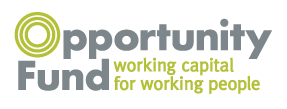 How did Opportunity Fund get to 2,000 deals per year? Opportunity Fund’s Director of Microlending, Devin McAlpine, walked us through the evolution of their program design in an August webinar.
How did Opportunity Fund get to 2,000 deals per year? Opportunity Fund’s Director of Microlending, Devin McAlpine, walked us through the evolution of their program design in an August webinar.
Download the slidedeck and listen to the webinar (67 minutes).
Up until 2011, Opportunity Fund’s program looked similar to most of the CDFIs in our network. Their loan officers sent applications into the underwriting department, who in turn, collected multiple years of tax returns, six months of bank statements and business licenses. They reviewed credit reports in a fairly conventional way, looking at all the past use of credit in making their final decision. With this model they expanded from 30 deals in 2008 to 300 deals in 2010. This would have been considered sufficient success for many CDFIs. But not for Opportunity Fund.
In 2011 they made dramatic changes to their model that has led to closing 2,000 deals per year. This model is radically different than that of the other CDFI’s in our network, giving us all a lot to consider. Here’s how they do it now.
Role of Loan Consultants
- Opportunity Fund’s loan consultants are a bit like in-the-field, a-to-z loan departments. Loan consultants are rarely behind their desks; they spend 3-4 days per week in the field. They each have a territory where they are responsible for outreach, bank and dealership relations, origination, applications, document collection, underwriting and collections.
- Loan Consultants have a team meeting once per week. Applications are sent for approval when the package is complete.
- Each Loan Consultant prepares and closes 7-14 deals per month that are held in his/her personal portfolio consisting of up to 250 loans.
Incentivized compensation
- Compensation to Loan Consultants shifted from straight salary to a split between salary and bonus.
- Base pay and bonuses are about 50% of annual compensation, but it’s possible for the monthly bonus to more than double monthly salary.
- Bonuses, calculated and paid monthly, are based on three factors: number of loans closed, dollar volume of loans closed and performance of that Loan Consultant’s personal portfolio.
Pared down underwriting and document collection
One great advantage of a large portfolio is that you can analyze the characteristics of your strong re-payers, learning what works without having to rely on standard industry assumptions. In doing this analysis on their portfolio, Opportunity Fund realized it could change its underwriting and document requirements and still maintain high repayment rates.
- Opportunity Fund is not a FICO based lender. Instead, they focus on payment history to credit cards and vehicle loans for the last 12 to 24 months, but comprehensive analysis of all credit history data is essential.
- For loans over $10,000, documents were reduced to 3 months bank statements, last year’s tax return, current year Profit and Loss statement.
- For loans $10,000 and under, only proof of being in business (which can be as simple as a picture) and a credit pull may be sufficient to award a loan.
Collateral
Opportunity Fund has no minimum collateral requirements and many of their small loans are not collateralized. On larger loans they will take a lien on business assets or a vehicle, but again, without a required loan-to-value ratio. “We have $70,000 loans in our portfolio collateralized with $3,000 cars,” said Devin.
Managing delinquencies
Each Loan Consultant’s portfolio is assigned a Collections Specialist. The Loan Consultant and Collector meet weekly to review all loans even one day late and discuss actions to get the client back on track.
“Opportunity Fund works with a delinquent client to maintain good credit and deepen the relationship,” says Devin. Loan Consultants work with clients to get current by offering business coaching. They also get creative by approving a skipped payment, a half payment or by restructuring the entire loan.
Opportunity Fund has a policy of collecting and confirming two personal references before disbursing a loan. They have found that phone numbers change, people move. Being able to track down a client through a family member or close friend is an integral piece of part of maintaining a solid connection to borrower and finding them when delinquencies occur.
With this pro-active approach, and tying bonuses to portfolio performance, OF maintains delinquency rate under 2% on its massive portfolio.
###
The big take-away from this webinar is Opportunity Fund’s willingness to reflect on its process, question the sacred cows of lending, conduct fresh analysis on its own portfolio performance and then, undertake the challenge of organizational and process change to improve performance and scale.
We strongly recommend you listen to this webinar if you missed it, or listen to it again if you attended. There’s a wealth of information and food for thought. We would like to continue this dialogue with all of you so our network can stay ahead of the microlending field. Thank you to Devin for offering this valuable webinar.